CIT’s New Wandesford Gallery to host Cork Craft Month Exhibition

Published on: Thursday, 15 July 2010
CIT’s new Wandesford Gallery hosts a new exhibition “Positive Space” featuring Ceramics from Sara Flynn and Nuala O’Donovan, both graduates of CIT Crawford College of Art and Design. The exhibition runs until August 28th, Wednesday – Saturday, 10am to 6pm, .
Sara Flynn was born in Cork and studied Ceramics at CIT Crawford College of Art, Cork and graduated in 1998. She established her first studio in 1999 in Kinsale and now works from her home and workshop in West Cork. Her work is exhibited extensively through galleries in Ireland and the UK and is held in many private and public collections, including the Department of Foreign Affairs, Farmleigh House Dublin, The National Museum of Ireland and Columbus State University, Georgia, USA.
 For Sara: “The major concerns that my work deals with are a love of the process of throwing, an ongoing relationship with porcelain and a fascination with the theme of the vessel, in both literal and abstracted interpretations. My work currently addresses two primary themes. The first deals with the enjoyment of the qualities of the porcelain and the practice of manipulating, cutting, and reassembling freshly thrown forms to highlight movement and volume. Roads, pathways and hedgerows as well as the curves and contours of the local landscape inform the alterations of the thrown form to produce sculptural decorative vessels. Drawn and abstracted observations of rural ancillary buildings and their subtle contrasting tones, contours, edges and textures further inspire the work.
For Sara: “The major concerns that my work deals with are a love of the process of throwing, an ongoing relationship with porcelain and a fascination with the theme of the vessel, in both literal and abstracted interpretations. My work currently addresses two primary themes. The first deals with the enjoyment of the qualities of the porcelain and the practice of manipulating, cutting, and reassembling freshly thrown forms to highlight movement and volume. Roads, pathways and hedgerows as well as the curves and contours of the local landscape inform the alterations of the thrown form to produce sculptural decorative vessels. Drawn and abstracted observations of rural ancillary buildings and their subtle contrasting tones, contours, edges and textures further inspire the work.
The second theme addresses the placement of the altered forms in relation to each other. The possibilities exist for the placing of inanimate objects (the vessels) to tell stories of group dynamics, protectiveness, inclusion and exclusion and family bonding. Some of my work deals with presenting the work in an installation structure in order to convey my ideas to the viewer.”
Nuala O’Donovan was born in Cork City. She spent a number of years living and working abroad and returned to Cork in 1997. She studied ceramics at CIT Crawford College of Art and Design, graduating with an MA in 2008. Since graduating, her work has been purchased for public and private collections in Ireland, the UK and Europe and has been published and exhibited nationally and internationally. She currently lives and works in Cork.
 In 2010/2011 O’Donovan’s work will be exhibited in Galleries and Museums in West Cork, Galway, Paris, New York, Mexico City, and London.
In 2010/2011 O’Donovan’s work will be exhibited in Galleries and Museums in West Cork, Galway, Paris, New York, Mexico City, and London.
“My work combines regular pattern with the characteristics of fractal forms from nature. Each element of the pattern is individually made; the form is constructed slowly over a period of weeks or months and fired a number of times during the making process. The finished forms are a result of an intuitive response to the direction that the pattern takes as well as the irregularity in the handmade elements of the pattern.
The result of using the characteristics of fractal geometry in making decisions regarding the form of the sculptural pieces is that the form is resolved but retains a sense of potential growth. I hope that the viewer engages with the piece by allowing their own personal experiences to influence their view of the outcome of the form and/or future possibilities. This aspect of my work also refers to the transitory quality of living organisms, which combine traces of history, the present and the future in the patterns found in their surfaces and forms.
I am interested in the narrative quality of irregularities in patterns in living organisms. The history behind a scarred or broken surface is what fascinates me. The evidence of a response to random events visible in patterns in nature is testament to the ability of living organisms to recover, to respond, and to continue growing and changing. It is the imperfections in the patterns caused by a unique experience that are evidence of the life force in living organisms.”






